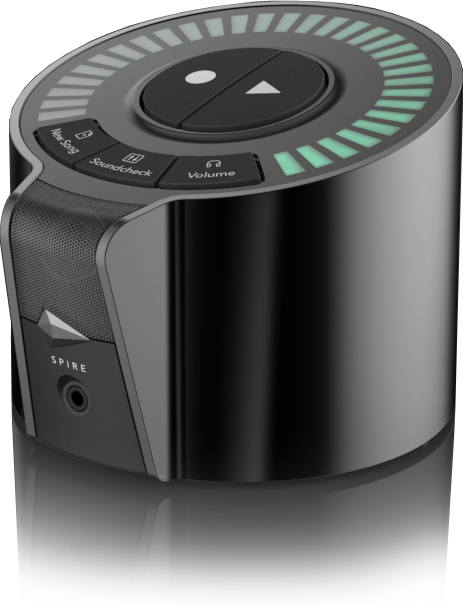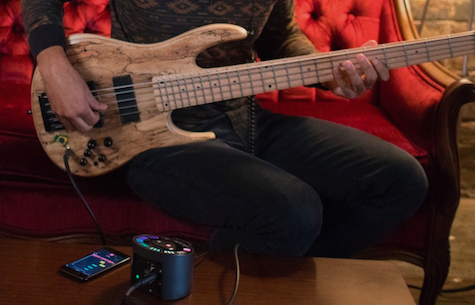New Gear Review: Spire Studio by iZotope

With Spire Studio, iZotope aims to provide songwriters with an easy-to-use, yet robust solution for capturing ideas on the go.
Too many musicians have invested some of their hard earned cash into state-of-the-art digital audio workstations, only to later find themselves too intimidated or too overburdened by the intricacies of the technology to actually spend any time with it.
Whenever inspiration hits, it’s crucial that artists can capture their ideas as quickly as possible. Unfortunately, home recordists and musicians who frequently find themselves on the road don’t always have the luxury of keeping their equipment within arms’ reach at a moment’s notice. Even when they do, there are often numerous steps to take before they can record anything usable.
iZotope has positioned their new product, Spire Studio, to minimize these hurdles, filling a niche once occupied by simple and portable 4-track cassette recorders, while adding much in the way of features and sound quality. Its goal: Making the recording of any impromptu jam, late-night songwriting collaboration, or multi-instrumental production nearly hassle-free.
Features
It’s important to realize that Spire Studio is not just a portable multi-track recording device. The base unit actually pairs with a free iOS app via Wi-fi, expanding its potential capability far further than its simple and minimalist design suggests.
The hardware is equipped with a built-in omnidirectional condenser mic, two XLR-1/4″ combo jacks with Grace Design preamps, phantom power, front and rear 3.5mm headphone inputs, and a touch-sensitive display. Also included are large Record and Play buttons, as well as buttons for starting a fresh project (New Song), automatically adjusting gain (Soundcheck), and regulating your output level (Volume). Spire Studio’s rechargeable lithium-ion battery lasts around 4 to 6 hours. The app will actually let you know (with a hard-to-miss red banner) when your unit’s battery is running low.
The Spire Studio App can easily be downloaded through the Apple Store. Inside, you’ll find the option to add, import, or delete projects. Projects allow you to set up a metronome (by tapping or inputing the BPM) with a few different time signature options, record with or without effects, edit your takes, and mix your tracks via an intuitively-designed visual mixer.
If you’re not connected to the hardware unit, you can choose to record with your phone mic or headphone mic. By default, the app will keep your phone awake while in a project and show data usage warnings if necessary. When you’ve finished a project, you can send the session through text or email, publish your song directly to social media and SoundCloud, and export your entire song—or just the individual tracks. Overall, you can comfortably record six hours of audio.
In Use
The device and app’s simplicity of use is worth commemorating right away. After turning on Spire Studio and downloading the app, I was able to record my acoustic guitar within seconds. The device’s Soundcheck feature instantly stood out to me; it’s a wonderful way of setting your recording levels. Generally speaking, I tend to be a little more conservative with my gain staging, but I will admit that it’s nice to press one button and let the device take the reins.
The unit’s recording quality exceeded my expectations. I threw a lot of different instruments at it, including vocals, acoustic guitar, electric guitar, bass guitar, shakers, tambourine, and a ukulele. Occasionally, I recorded with two mics at once, either with two of my own mics or the unit’s built-in mic plus one of my own. You can have a maximum of two inputs active at any given time—connecting a mic or instrument to Input 1 will disable the unit’s built-in mic.

In addition to 8 tracks of audio accessible via the Spire App, the unit also offers several basic effects and amp emulations.
I was surprised by how refined everything sounded. iZotope hasn’t spoken much about the magic they slipped in under the hood, but to my ears, there has to be some compression, EQ, and noise reduction sprinkled into the recording chain.
Unfortunately, there are no individual processing abilities afforded to you, but you do have the option to add one effect (a choice between 3 “amps” or 5 “spaces”) before recording. You’re not able to add or remove any effects after the fact, so it’s important to be conscious of whether they really suit the part. Still, it was nice to have the ability to tweak things and try various amp modelers and time-based effects while recording.
Spire Studio’s touch screen functionality is really cool. If you need to adjust your volume or select a track for overdubs, it couldn’t be simpler. Each track is given its own bright color, making it a breeze to differentiate between them. Another standout feature is the app’s mix window, where your tracks are represented by circles that you can drag to the left or right (panning), and up or down (volume). The mix window also grants you the ability to hear your song in mono and mute any one of your tracks.
Exporting and uploading an entire project from the app to my Dropbox account only took about two minutes. (Of course, the amount of time is always dependent upon the length of the song and number of tracks.) From there, I was able to move the zip file containing my individual tracks onto my computer and into my DAW. (Note: all audio is recorded at 48kHz/24-bit, but your tracks will automatically be converted to 44.1kHz/24-bit when exported.)
To Be Critical
Despite the great features available in Spire Studio, a few cons did stick out to me. First off, there’s no guitar/bass tuner in the app or device. This would have been such a fantastic tool, and I couldn’t help but feel like iZotope missed an opportunity there.
The app’s editing functionality is also extremely primitive. There’s no way of copying, pasting, or moving waveforms; you can only trim whatever is to the left or right of your selector. In addition, many users may be disappointed to learn that there’s currently no Android compatibility, though iZotope has confirmed that they are working on it. However, as of May 2018, you’re out of luck if you don’t have an iOS device.
Unfortunately, because you’re connected to the base unit via Wi-fi, you can’t be connected to the internet via Wi-fi at the same time. It’s a little annoying to need to disconnect from the device in order to send/receive files in a timely fashion if you’re planning on going back into the app. It would be cool if they offered an additional cabled connection to the hardware unit.
The total of 8 stereo tracks offered by Spire will likely be fine for most singer-songwriters, but I found it somewhat limiting for professional use. (Don’t expect to be able to double many instruments, for example.)
Additionally, it would be incredible to have the option to add odd time signatures and adjust which beats are accented on the metronome.
The unit is also shaped somewhat oddly, and I nearly dropped it twice while positioning it around my room. When traveling, I wouldn’t recommend just sticking the unit in your bag. A durable case or bag is currently included for a limited time, but it’s typically sold separately.
Lastly, my device had a distinct, electronic odor. It wasn’t terribly strong, but I did pick up on it a few times, especially when the unit was powered on for a little while. I was told by a customer service representative that this is already a documented issue, but it has no impact on the performance of the unit.
Summing it Up
It’s not difficult to see who iZotope is targeting based on Spire Studio’s heavily-marketed videos. These videos feature acclaimed songwriters like Laura Jane Grace of Against Me!, Kurt Vile and Courtney Barnett, Matt Berninger of The National, and Anaïs Mitchell.
Despite the joke that LJG makes in her video, Spire Studio is by no means expected to replace professional studios or the audio workers who populate them. (Given the company’s wide range of industry standard products, that would be a strange business model on their part.) It’s a lot more fitting to say that Spire Studio has situated itself as a very attractive alternative to your smartphone’s embedded recording software.
At $350, Spire Studio might seem a bit pricey for the average singer-songwriter, but you’re definitely getting a lot of bang for your buck. This is a powerful recording device for serious musicians that are looking to have more control over their demos without getting bogged down by complex hardware/software.
Michael Duncan is a record producer, engineer, and writer who lives in NYC.
Please note: When you buy products through links on this page, we may earn an affiliate commission.






